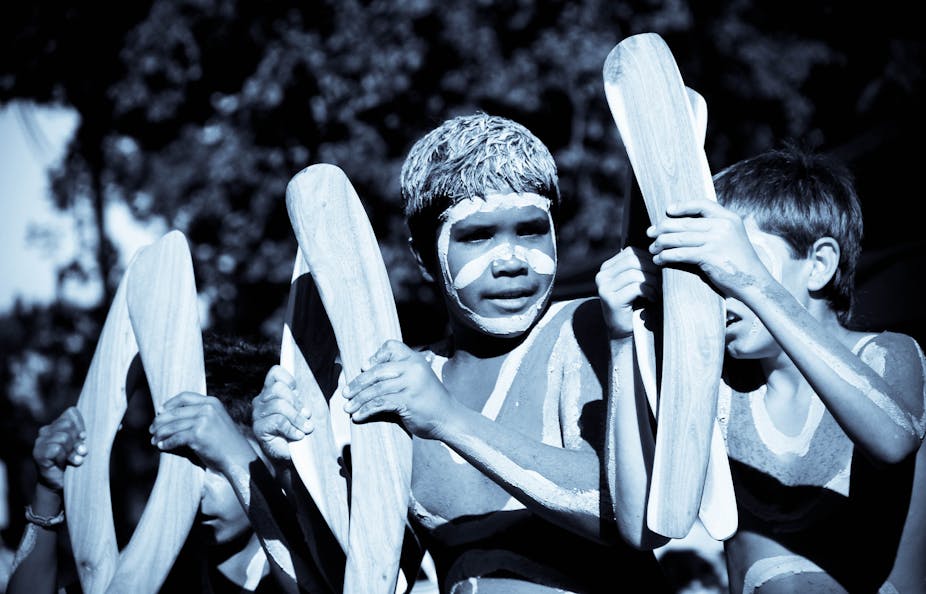Australian Indigenous performance traditions, among the oldest in the world, are also among the most endangered. According to a Statement on Indigenous Australian Music and Dance endorsed in 2011 by the International Council for Traditional Music, around 98% of Aboriginal and Torres Strait Islander music traditions have already been lost.
Without urgent action, those remaining are at risk of disappearing within a generation or two. The loss, the Statement suggests, comes from “[m]odern lifestyles and the ongoing devastating impact of colonisation”, which are “affecting the dissemination of cultural knowledge between generations”.
“Many senior composers and performers,” it continues, “have passed away leaving limited or no record of their knowledge.”
Initiatives such as the National Recording Project for Indigenous Performance and the recently-launched Living Archive of Aboriginal Languages are, of course, good news, but much still remains to be done – and the situation is becoming increasingly urgent as time passes.
For the individuals and communities affected, there are many reasons why this loss matters. For one thing, songs, dances and ceremonial performances can contribute to a sense of individual and community identity. In the words of senior Tiwi woman Lenie Tipiloura,
If all the old songs are lost, then we don’t remember who we are.
Or as Murray Islander Toby Whaleboat says, this element of culture:
just gives us a sense of who we are.
There are also spin-off benefits to keeping cultural traditions strong, including positive health and wellbeing outcomes. Benefits such as these are often used to advocate for greater government support for Aboriginal and Torres Strait Islander communities who wish to document, maintain and revitalise their cultural practices. They are important and valid reasons.
But they risk leaving non-Indigenous Australians to wonder why – or even whether – this loss really matters to us. If it’s hard to imagine how it feels to watch our language, songs, stories and other cultural practices vanish, it’s perhaps even harder to think of any dire consequences for us when these traditions are no longer practised. So why should non-Indigenous Australians care about this cultural crisis?
A unique expression
As with cultural traditions the world over, Australian Indigenous performance traditions are a unique expression of what it is to be human. They represent a continuum of intellect and imagination through the generations. They offer a direct glimpse at the creativity of the human mind.
As such, their loss (like that of hundreds of other threatened expressions of culture across the world) is a loss to the common heritage of humanity. For those with a global outlook, that’s one reason we might care about their disappearance.

Then there’s the contribution these traditions make to global cultural diversity – and there are many reasons why diversity matters. One is simply that current performance traditions are almost always nourished by older ones, which form a point of departure for invention and transformation. (Take Geoffrey Gurrumul Yunupingu as a case in point.)
Current traditions will inform future ones, too. That is what UNESCO refers to when it says cultural diversity “widens the range of options open to everyone”. That includes you, me and whoever else might enjoy listening to music, going to a show, or hanging out at a festival now and then.
And then there’s mutual understanding. Protecting, promoting and celebrating our country’s rich diversity of both Indigenous and non-Indigenous performance traditions means we may reap the benefits of their remarkable ability to promote cross-cultural understanding, exchange, reconciliation and peace. In Toby Whaleboat’s words:
Australia’s talking so much about reconciliation. One thing great about music – it can reconcile people, bring people together.

Finally, as with many other indigenous traditions across the world, Australian performance traditions are closely interconnected with other kinds of cultural expression, as well as with local ways of understanding and being in the world. The loss of a dance, say, may mean the unique story it carries is forgotten too.
Songs in particular can be important vehicles for transmitting local cultural and historical information, encoding knowledge of genealogies and mythologies, records of ancestors and kinships, knowledge of the universe and the land, medicinal and culinary knowledge, social norms, taboos, histories, and cultural skills and practices, among other things. So when those songs disappear, much more than the songs themselves is lost.
One music researcher has convincingly argued that the disappearance of Australian Aboriginal songs could “potentially compromise our ability to adapt to as yet unforeseen changes”. Songs may contain information (ecological knowledge, for instance) that could help us deal with contemporary issues challenging the future of our country – even the planet.
In short, the effects of losing these traditions extend well beyond Aboriginal and Torres Strait Islander communities themselves. We’ve begun to take notice of the loss and the possible consequences.
Now, the challenge is for us to care enough about what is happening so that we may respectfully and collaboratively take whatever action is appropriate to help recover what we – all of us – are losing.

